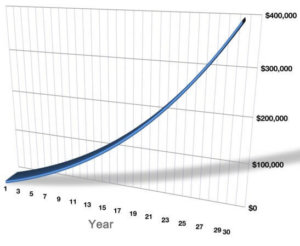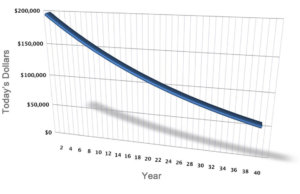The impact of 3% yearly inflation on the purchasing power of $200,000
Savings builds a foundation
The first step in investing is to secure a strong financial foundation. Start with these four basic steps:
- Create a “rainy day” reserve: Set aside enough cash to get you through an unexpected period of illness or unemployment–three to six months’ worth of living expenses is generally recommended. Because you may need to use these funds unexpectedly, you’ll generally want to put the cash in a low-risk, liquid investment.
- Pay off your debts: It may make more sense to pay off high-interest-rate debt (for example, credit card debt) before making investments that may have a lower or more uncertain return.
- Get insured: There is no better way to put your extra cash to work for you than by having adequate insurance. It’s your best protection against financial loss, so review your home, auto, health, disability, life, and other policies, and increase your coverage, if needed.
- Max out any tax-deferred retirement plans, such as 401(k)s and IRAs: Putting money in these accounts defers income taxes, which means you’ll have more money to save. Take full advantage if they are available to you.
Why invest?
To try to fight inflation
When people say, “I’m not an investor,” it’s often because they worry about the potential for market losses. It’s true that investing involves risk as well as reward, and investing is no guarantee that you’ll beat inflation or even come out ahead. However, there’s also another type of loss to be aware of: the loss of purchasing power over time. During periods of inflation, each dollar you’ve saved will buy less and less as time goes on.
To take advantage of compound interest
Anyone who has a savings account understands the basics of compounding: The funds in your savings account earn interest, and that interest is added to your account balance. The next time interest is calculated, it’s based on the increased value of your account. In effect, you earn interest on your interest. Many people, however, don’t fully appreciate the impact that compounded earnings can have, especially over a long period of time.

Note: This is a hypothetical example and is not intended to reflect the actual performance of any specific investment. Taxes and investment fees and expenses are not reflected. If they were, the results would be lower. Actual results will vary. Rates of return will vary over time, particularly for long-term investments.
Let’s say you invest $5,000 a year for 30 years (see illustration). After 30 years you will have invested a total of $150,000. Yet, assuming your funds grow at exactly 6% each year, after 30 years you will have over $395,000, because of compounding.
Compounding has a “snowball” effect. The more money that is added to the account, the greater its benefit. Also, the more frequently interest is compounded–for example, monthly instead of annually–the more quickly your savings build. The sooner you start saving or investing, the more time and potential your investments have for growth. In effect, compounding helps you provide for your financial future by doing some of the work for you.
Copyright 2006- Broadridge Investor Communication Solutions, Inc. All rights reserved.
Broadridge Investor Communication Solutions, Inc. does not provide investment, tax, or legal advice. The information presented here is not specific to any individual’s personal circumstances.
To the extent that this material concerns tax matters, it is not intended or written to be used, and cannot be used, by a taxpayer for the purpose of avoiding penalties that may be imposed by law. Each taxpayer should seek independent advice from a tax professional based on his or her individual circumstances.
These materials are provided for general information and educational purposes based upon publicly available information from sources believed to be reliable—we cannot assure the accuracy or completeness of these materials. The information in these materials may change at any time and without notice.
*Non-deposit investment products and services are offered through CUSO Financial Services, L.P. (“CFS”), a registered broker-dealer (Member FINRA / SIPC) and SEC Registered Investment Advisor. Products offered through CFS: are not NCUA/NCUSIF or otherwise federally insured, are not guarantees or obligations of the credit union, and may involve investment risk including possible loss of principal. Investment Representatives are registered through CFS. Coastal Federal Credit Union has contracted with CFS to make non-deposit investment products and services available to credit union members.
CFS representatives do not provide tax or legal guidance. For such guidance please consult with a qualified professional. Information shown is for general illustration purposes and does not predict or depict the performance of any investment or strategy. Past performance does not guarantee future results.
Trust Services are available through MEMBERS Trust Company. CFS* is not affiliated with Members Trust Company.







